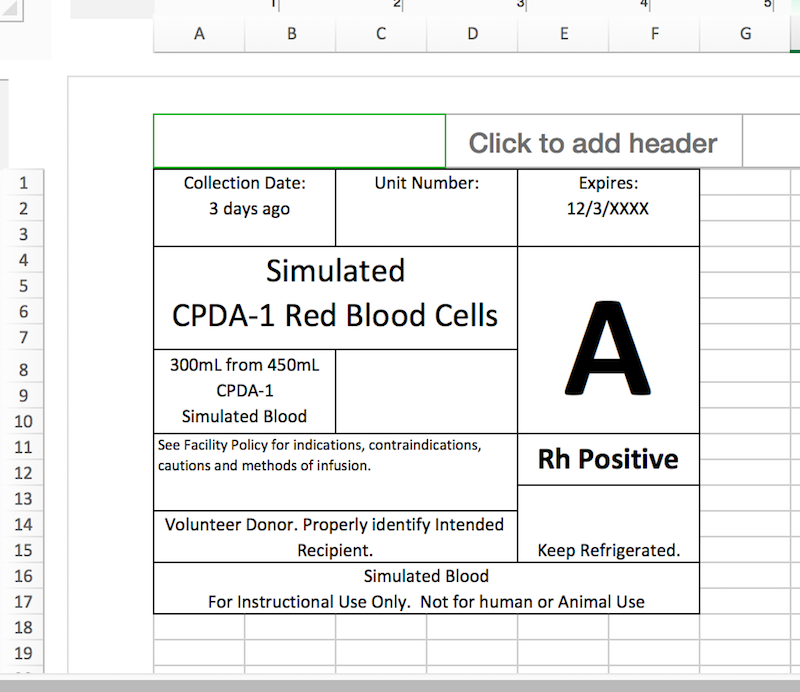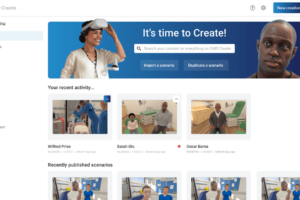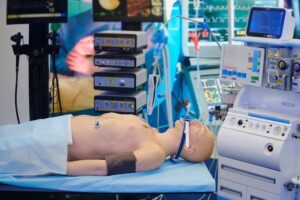Blood Transfusion Documents and Excel Labels for Simulation in Healthcare — Includes Template
Blood transfusions may be found in a variety of simulations such as those involving bleeding peptic ulcers, postoperative hemorrhage, postpartum hemorrhage or mass casualty situations. The cost of blood bags (around $20 each) limits the number of times students can spike bags. Blood bags can easily be made using a 250 or 500 mL normal saline bags with an appropriate blood label. Inexpensive food dye can be added to create the blood color (Smart and Final sells huge bottles of food dye relatively cheaply). Use Excel to generate labels for each blood group (see an earlier HealthySimulation.com article entitled Building Healthcare Simulation Documents Using Excel – Tips and Tricks). Remember when using Excel, keep your columns and rows identical sizes but select and merge blocks of cells to create various shapes in your label or form. Following this tip allows any size block to be generated.
Administration Forms
- When blood or blood products are transfused, two licensed healthcare personnel must check the patient identification against the crossmatched unit of blood at the bedside.
- A special form must be completed which includes among other things vital signs and information about the start and end time of the transfusion.
- If there is any kind of transfusion reaction, the blood bag, saline bag and all tubing along with the completed transfusion form must be returned to the blood band for an investigation.
- See the link in this article is an Excel generated transfusion form. The form can be changed to match different institutions.
Notes About Transfusions
Sponsored Content:
- The equipment for a non-emergent transfusion setup includes:
- Blood bag (usually packed red blood cells)
- Normal saline bag 250mL (0.9% sodium chloride).
- The osmolarity (salt concentration) of normal saline matches human blood. If solutions with more salt e.g. 3% sodium chloride are used, blood cells will shrink. Conversely, very dilute solutions such as 0.225% sodium chloride will cause blood cells to swell and burst.
- Y set IV tubing. Two bags (blood and normal saline) can be spiked and then run separately or together.
- Make the learners think.
- Do not provide learners with just 0.9% sodium chloride bags instead include a variety of concentrations. Students have to think about which solution to use. Occasionally students will pick up the wrong bag.
- The tubing is first flushed (primed) with saline and then the saline bag is closed.
- There should be sufficient saline in the drip chamber to prevent damage to blood cells as they drip into the chamber.
- The blood bag is then opened.
- Start the blood infusion slowly at about 5 mL/min. Slow administration allows time to observe for adverse reactions.
- Vital signs are collected immediately before the transfusion begins and then at 5 minutes, 15 minutes and then every 30 minutes (note different institutions may have different policies).
- Blood not used must be returned to the blood bank within 30 minutes.
- Blood groups/Compatibilities
- Group A (Can receive blood from A, O)
- Group B (Can receive blood from B, O)
- Group AB (Can receive blood from A, B, AB, O). Universal Recipient.
- Group O (Can receive blood from O). Universal donor.
- Blood products:
- Packed red blood cells are usually used for transfusions.
- In emergency situations group O red blood cells may be given.
- Whole blood must be matched for groups
- Improves oxygen carrying capacity of the blood since red blood cells contain hemoglobin which transport oxygen.
- In emergency situations group O red blood cells may be given.
- Platelets
- For thrombocytopenia (low platelets) – patient at risk for bleeding.
- Albumin
- Expands blood volume but does not increase oxygen carrying capacity of the blood
- Fresh frozen plasma (FFP)
- Restores clotting factors.
- Should be ABO compatible
- Cryoprecipitate
- Restores fibrinogen which is important for clotting mechanisms.
- Packed red blood cells are usually used for transfusions.
Download the HealthySim Blood Transfusion Template here!
Download the HealthySim Blood Bag Label Template Here!
Maintaining fidelity during simulations helps learners to focus on the scenario rather than the scenario setup. Making low cost blood bags will cut down the cost of running scenarios with transfusions and hopefully allow more learners the opportunity of setting up and running blood transfusions.
Today’s article was guest authored by Kim Baily PhD, MSN, RN, CNE, Simulation Coordinator for Los Angeles Harbor College. Over the past 15 years Kim has developed and implemented several college simulation programs and currently chairs the Southern California Simulation Collaborative.
Sponsored Content:
Have a story to share with the global healthcare simulation community? Submit your simulation news and resources here!
Learn more about Blood Transfusion Documents and Labels Using Excel!
Dr. Kim Baily, MSN, PhD, RN, CNE has had a passion for healthcare simulation since she pulled her first sim man out of the closet and into the light in 2002. She has been a full-time educator and director of nursing and was responsible for building and implementing two nursing simulation programs at El Camino College and Pasadena City College in Southern California. Dr. Baily is a member of both INACSL and SSH. She serves as a consultant for emerging clinical simulation programs and has previously chaired Southern California Simulation Collaborative, which supports healthcare professionals working in healthcare simulation in both hospitals and academic institutions throughout Southern California. Dr. Baily has taught a variety of nursing and medical simulation-related courses in a variety of forums, such as on-site simulation in healthcare debriefing workshops and online courses. Since retiring from full time teaching, she has written over 100 healthcare simulation educational articles for HealthySimulation.com while traveling around the country via her RV out of California.
Sponsored Content:



















